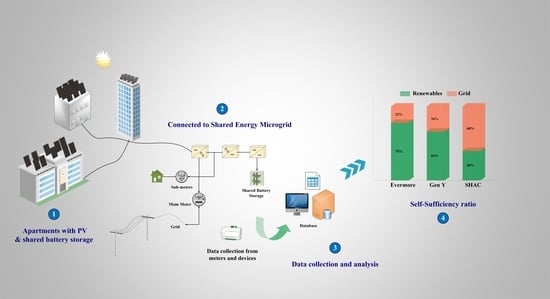Shared Solar and Battery Storage Configuration Effectiveness for Reducing the Grid Reliance of Apartment Complexes
Abstract
1. Introduction
- Section 2 briefly reviews DRES in residential buildings and identifies the reasons for the low uptake of DRES in apartment buildings.
- Section 3 discusses the role of battery storage in reducing grid reliance and achieving self-sufficiency as supported by the recent research literature.
- Section 4 presents the concept of shared systems.
- The case study is presented in Section 5, which also includes details about microgrid configurations and metering.
- Section 6 describes the methodology and analysis used for the study.
- Section 7 presents analyzed results obtained from the shared configurations on three sites.
- Finally, the paper is concluded in Section 8 by highlighting main outcomes and suggestions for future research.
2. DRES in Residential Dwellings
Low Uptake of DRES in Apartments
3. Battery Storage in Mitigating Grid Reliance
Literature Reference
4. Shared Systems
5. Case Study: WGV
5.1. SEM Configurations
6. Methodology and Analysis
6.1. Data Collection
6.2. Analysis
7. Results and Discussions
7.1. Seasonal Load Profiles
7.2. Diurnal Load Profiles
7.3. Self-Sufficiency
8. Conclusions and Future Recommendations
Author Contributions
Funding
Conflicts of Interest
Appendix A

Appendix B
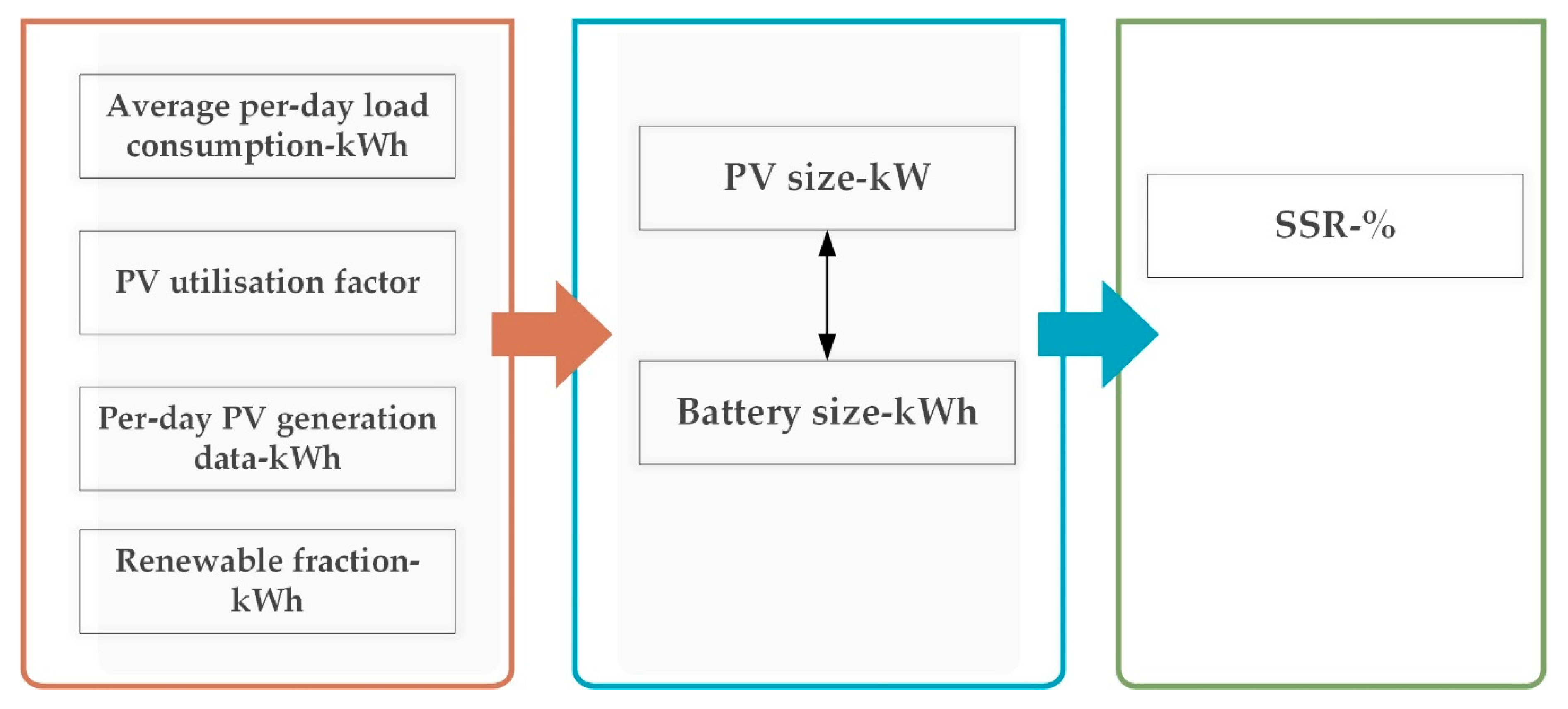
References
- Swanston, M. Two Million Plus Solar Roofs: What’s in It for the Consumers? Behind and Beyond the Meter; Elsevier: Amsterdam, The Netherlands, 2020; pp. 381–406. [Google Scholar] [CrossRef]
- Western-Power. Network Integration Guideline: Inverter Embedded Generation. 2019. Available online: https://westernpower.com.au/media/3403/network-integration-guideline-inverter-embedded-generation-20190802.pdf (accessed on 20 May 2020).
- Syed, M.M.; Hansen, P.; Morrison, G.M. Performance of a shared solar and battery storage system in an Australian apartment building. Energy Build. 2020, 225, 110321. [Google Scholar] [CrossRef]
- Imteaz, M.A.; Ahsan, A. Solar panels: Real efficiencies, potential productions and payback periods for major Australian cities. Sustain. Energy Technol. Assess. 2018, 25, 119–125. [Google Scholar] [CrossRef]
- Rae, C.; Bradley, F. Energy autonomy in sustainable communities—A review of key issues. Renew. Sustain. Energy Rev. 2012, 16, 6497–6506. [Google Scholar] [CrossRef]
- Luthander, R.; Widén, J.; Nilsson, D.; Palm, J. Photovoltaic self-consumption in buildings: A review. Appl. Energy 2015, 142, 80–94. [Google Scholar] [CrossRef]
- Gudmunds, D.; Nyholm, E.; Taljegard, M.; Odenberger, M. Self-Consumption and Self-Sufficiency for Household Solar Producers When Introducing an Electric Vehicle. SSRN Electron. J. 2018, 148, 1200–1215. [Google Scholar] [CrossRef]
- Quoilin, S.; Zucker, A. Techno-Economic Evaluation of Self-Consumption with Pv/Battery Systems under Different Regulation Schemes. In Proceedings of the 29th international conference on Efficiency, Cost, Optimisation, Simulation and Environmental Impact of Energy Systems, Portoroz, Slovenia, 19–23 June 2016; Available online: http://hdl.handle.net/2268/205134 (accessed on 5 June 2020).
- Zhang, Y.; Lundblad, A.; Campana, P.E.; Yan, J. Employing Battery Storage to Increase Photovoltaic Self-sufficiency in a Residential Building of Sweden. Energy Procedia 2016, 88, 455–461. [Google Scholar] [CrossRef]
- Sugiartha, N.; Sugina, I.M.; Widiantara, I.B.G.; Tri Putra, I.D.G.A.; Indra, I.B.P. Solar photovoltaic system with self-consumption in villa. J. Phys. Conf. Ser. 2020, 1450, 012105. [Google Scholar] [CrossRef]
- Masson, G.; Briano, J.I.; Baez, M.J. Review and analysis of PV self-consumption policies. IEA Photovolt. Power Syst. Program. (PVPS) 2016, 1, 1–82. Available online: https://www.sunwindenergy.com/sites/default/files/iea-pvps_-_self-consumption_policies_-_2016_-_2_0.pdf (accessed on 5 June 2020).
- Gstöhl, U.; Pfenninger, S. Energy self-sufficient households with photovoltaics and electric vehicles are feasible in temperate climate. PLoS ONE 2020, 15, e0227368. [Google Scholar] [CrossRef]
- Kabir, E.; Kumar, P.; Kumar, S.; Adelodun, A.A.; Kim, K.-H. Solar energy: Potential and future prospects. Renewable and Sustainable. Energy Rev. 2018, 82, 894–900. [Google Scholar] [CrossRef]
- Üçtuğ, F.G.; Azapagic, A. Environmental impacts of small-scale hybrid energy systems: Coupling solar photovoltaics and lithium-ion batteries. Sci. Total Environ. 2018, 643, 1579–1589. [Google Scholar] [CrossRef] [PubMed]
- Australian-Government. Australia’s 2030 Climate Change Target. 2015. Available online: https://publications.industry.gov.au/publications/climate-change/system/files/resources/c42/factsheet-australias-2030-climate-change-target.pdf (accessed on 1 July 2020).
- Roberts, M.B.; Bruce, A.; MacGill, I. Collective Prosumerism: Accessing the Potential of Embedded Networks to Increase the Deployment of Distributed Generation on Australian Apartment Buildings. In Proceedings of the 2018 IEEE International Energy Conference (ENERGYCON), Limassol, Cyprus, 3–7 June 2018. [Google Scholar] [CrossRef]
- ABS Telling storeys—Characteristics of apartment building heights. 8752.0—Building Activity Australia. 2018. Available online: https://www.abs.gov.au/ausstats/abs@.nsf/Lookup/8752.0Feature+Article1Dec%202018 (accessed on 25 June 2020).
- Easthope, H.; Caitlin, B.; Vandana, M.; Australian National Strata Data 2018. UNSW. Available online: https://cityfutures.be.unsw.edu.au/research/projects/national-strata-data-analysis/ (accessed on 25 June 2020).
- Shoory, M.; The Growth of Apartment Construction in Australia. RBA Bulletin, 19–26 June 2016. Available online: https://www.rba.gov.au/publications/bulletin/2016/jun/pdf/bu-0616-3.pdf (accessed on 25 June 2020).
- Müller, S.C.; Welpe, I.M. Sharing electricity storage at the community level: An empirical analysis of potential business models and barriers. Energy Policy 2018, 118, 492–503. [Google Scholar] [CrossRef]
- Green, J.; Newman, P. Citizen utilities: The emerging power paradigm. Energy Policy 2017, 105, 283–293. [Google Scholar] [CrossRef]
- Roberts, M.B.; Huxham, G.; Bruce, A.; MacGill, I.; Strata, A.E. Using PV to help meet Common Property Energy Demand in Residential Apartment Buildings. In Proceedings of the Australian Summer Study on Energy Productivity, University of Technology, Sydney, Australia, 24–26 February 2016. [Google Scholar] [CrossRef]
- Roberts, M.; Bruce, A.; MacGill, I. PV for Apartment Buildings: Which Side of the Meter? In Proceedings of the Asia Pacific Solar Research Conference. Melbourne, Australia, 5–7 December 2017; Available online: https://apo.org.au/node/234221 (accessed on 2 June 2020).
- Castellazzi, L.; Bertoldi, P.; Economidou, M. Overcoming the Split Incentive Barrier in the Building Sector; Publications Office of the European Union: Luxembourg, 2017; Available online: https://ec.europa.eu/jrc/en/publication/eur-scientific-and-technical-research-reports/overcoming-split-incentive-barrier-building-sector (accessed on 27 June 2020).
- Melvin, J. The split incentives energy efficiency problem: Evidence of underinvestment by landlords. Energy Policy 2018, 115, 342–352. Available online: http://dx.doi.org/10.1016/j.enpol.2017.11.069 (accessed on 1 July 2020). [CrossRef]
- Fina, B.; Fleischhacker, A.; Auer, H.; Lettner, G. Economic Assessment and Business Models of Rooftop Photovoltaic Systems in Multiapartment Buildings: Case Studies for Austria and Germany. J. Renew. Energy 2018, 2018, 1–16. [Google Scholar] [CrossRef]
- Hirsch, A.; Parag, Y.; Guerrero, J.M. Microgrids: A review of technologies, key drivers, and outstanding issues. Renew. Sustain. Energy Rev. 2018, 90, 402–411. [Google Scholar] [CrossRef]
- Humphries, H.E.H. Evaluation of PV Systems in Gårdsten. In Citeseer; Doctoral Dissertation, University of Chalmers: Göteborg, Sweden, 2013; pp. 1–62. Available online: http://publications.lib.chalmers.se/records/fulltext/185610/185610.pdf (accessed on 29 June 2020).
- Komendantova, N.; Manuel Schwarz, M.; Amann, W. Economic and regulatory feasibility of solar PV in the Austrian multi-apartment housing sector. AIMS Energy 2018, 6, 810–831. [Google Scholar] [CrossRef]
- Sommerfeldt, N.; Muyingo, H. Lessons in Community Owned PV from Swedish Multi-Family Housing Cooperatives. In Proceedings of the 31st European Photovoltaic Solar Energy Conference and Exhibition, Hamburg, Germany, 14–18 September 2015; pp. 2745–2750. Available online: http://kth.diva-portal.org/smash/record.jsf?pid=diva2%3A1048957&dswid=8818 (accessed on 29 June 2020).
- Sommerfeldt, N.; Madani, H. Solar PV for Swedish Prosumers—A Comprehensive Techno-Economic Analysis. In Proceedings of the EuroSun2016, International Solar Energy Society, Palma, Spain, 11–14 October 2016; Available online: http://dx.doi.org/10.18086/eurosun.2016.08.01 (accessed on 30 June 2020).
- Roberts, M.B.; Haghdadi, N.; Bruce, A.; MacGill, I. Cluster-based characterisation of Australian apartment electricity demand and its implications for low-carbon cities. Energy 2019, 180, 242–257. [Google Scholar] [CrossRef]
- Jung, W.; Jeong, J.; Kim, J.; Chang, D. Optimization of hybrid off-grid system consisting of renewables and Li-ion batteries. J. Power Sources 2020, 451, 227754. [Google Scholar] [CrossRef]
- Council, S.E. Australian Energy Storage Market Analysis; Smart Energy Council: Canberra, Australia, 2018; pp. 1–40. Available online: https://www.smartenergy.org.au/sites/default/files/uploaded-content/field_f_content_file/australian_energy_storage_market_analysis_report_sep18_final.pdf (accessed on 30 June 2020).
- Chen, B.; Xiong, R.; Li, H.; Sun, Q.; Yang, J. Pathways for sustainable energy transition. J. Clean. Prod. 2019, 228, 1564–1571. [Google Scholar] [CrossRef]
- Abdel-Monem, M.; Hegazy, O.; Omar, N.; Trad, K.; Van den Bossche, P.; Van Mierlo, J. Lithium-ion batteries: Comprehensive technical analysis of second-life batteries for smart grid applications. In Proceedings of the 2017 19th European Conference on Power Electronics and Applications (EPE’17 ECCE Europe), Warsaw, Poland, 11–14 September 2017; Available online: http://dx.doi.org/10.23919/epe17ecceeurope.2017.8099385 (accessed on 2 July 2020).
- Gjorgievski, V.; Cundeva, S. The Effects of Residential Battery Storage on Grid Impact Indicators. In Proceedings of the 2019 IEEE Milan PowerTech, Milan, Italy, 27 June 2019. [Google Scholar] [CrossRef]
- Gupta, R.; Bruce-Konuah, A.; Howard, A. Achieving energy resilience through smart storage of solar electricity at dwelling and community level. Energy Build. 2019, 195, 1–15. [Google Scholar] [CrossRef]
- Klingler, A.-L.; Teichtmann, L. Impacts of a forecast-based operation strategy for grid-connected PV storage systems on profitability and the energy system. Sol. Energy 2017, 158, 861–868. [Google Scholar] [CrossRef]
- Agnew, S.; Dargusch, P. Consumer preferences for household-level battery energy storage. Renew. Sustain. Energy Rev. 2017, 75, 609–617. [Google Scholar] [CrossRef]
- McKenna, E.; Darby, S.J. How Much Could Domestic Demand Response Technologies Reduce CO2 Emissions? European Council for an Energy-Efficiency Economy. ECEEE 2017 Summer Study—Consumption, Efficiency & Limits. 2017. Available online: https://www.eceee.org/library/conference_proceedings/eceee_Summer_Studies/2017/2-policy-governance-design-implementation-and-evaluation-challenges/how-much-could-domestic-demand-response-technologies-reduce-co2-emissions/ (accessed on 4 July 2020).
- Dato, P.; Durmaz, T.; Pommeret, A. Smart grids and renewable electricity generation by households. Energy Econ. 2020, 86. [Google Scholar] [CrossRef]
- Alimardani, M.; Narimani, M.; Al-Mutawaly, N. A New Approach to Improve Li-Ion Battery Lifetime in Home Energy Storage System with Photovoltaic Modules. In Proceedings of the 2018 IEEE Canadian Conference on Electrical & Computer Engineering (CCECE), Quebec City, QC, Cananda, 13–16 May 2018. [Google Scholar] [CrossRef]
- De Oliveira e Silva, G.; Hendrick, P. Photovoltaic self-sufficiency of Belgian households using lithium-ion batteries, and its impact on the grid. Appl. Energy 2017, 195, 786–799. [Google Scholar] [CrossRef]
- Barzegkar-Ntovom, G.A.; Chatzigeorgiou, N.G.; Nousdilis, A.I.; Vomva, S.A.; Kryonidis, G.C.; Kontis, E.O.; Georghiou, G.E.; Christoforidis, G.C.; Papagiannis, G. Assessing the viability of battery energy storage systems coupled with photovoltaics under a pure self-consumption scheme. Renew. Energy 2020, 152, 1302–1309. [Google Scholar] [CrossRef]
- Marczinkowski, H.M.; Østergaard, P.A. Residential versus communal combination of photovoltaic and battery in smart energy systems. Energy 2018, 152, 466–475. [Google Scholar] [CrossRef]
- Tomc, E.; Vassallo, A.M. The effect of individual and communal electricity generation, consumption and storage on urban Community Renewable Energy Networks (CREN): An Australian case study. Int. J. Sustain. Energy Plan. Manag. 2016, 11, 15–32. [Google Scholar] [CrossRef]
- Fares, R.L.; Webber, M.E. The impacts of storing solar energy in the home to reduce reliance on the utility. Nat. Energy 2017, 2, 17001. [Google Scholar] [CrossRef]
- Roberts, M.B.; Bruce, A.; MacGill, I. Impact of shared battery energy storage systems on photovoltaic self-consumption and electricity bills in apartment buildings. Appl. Energy 2019, 245, 78–95. [Google Scholar] [CrossRef]
- Wu, C.; Kalathil, D.; Poolla, K.; Varaiya, P. Sharing electricity storage. In Proceedings of the 2016 IEEE 55th Conference on Decision and Control (CDC), Las Vegas, NV, USA, 12–16 December 2016. [Google Scholar] [CrossRef]
- Rodrigues, D.L.; Ye, X.; Xia, X.; Zhu, B. Battery energy storage sizing optimisation for different ownership structures in a peer-to-peer energy sharing community. Appl. Energy 2020, 262, 114498. [Google Scholar] [CrossRef]
- AlSkaif, T.; Luna, A.C.; Zapata, M.G.; Guerrero, J.M.; Bellalta, B. Reputation-based joint scheduling of households appliances and storage in a microgrid with a shared battery. Energy Build. 2017, 138, 228–239. [Google Scholar] [CrossRef]
- Taşcıkaraoğlu, A. Economic and operational benefits of energy storage sharing for a neighborhood of prosumers in a dynamic pricing environment. Sustain. Cities Soc. 2018, 38, 219–229. [Google Scholar] [CrossRef]
- Tomc, E.; Vassallo, A.M. Community electricity and storage central management for multi-dwelling developments: An analysis of operating options. Int. J. Sustain. Energy Plan. Manag. 2018, 17, 15–30. [Google Scholar] [CrossRef]
- Rafsanjani, H.N.; Ahn, C. Linking Building Energy-Load Variations with Occupants’ Energy-Use Behaviors in Commercial Buildings: Non-Intrusive Occupant Load Monitoring (NIOLM). Procedia Eng. 2016, 145, 532–539. [Google Scholar] [CrossRef]
- Rouleau, J.; Gosselin, L.; Blanchet, P. Robustness of energy consumption and comfort in high-performance residential building with respect to occupant behavior. Energy 2019, 188, 115978. [Google Scholar] [CrossRef]
- Delzendeh, E.; Wu, S.; Lee, A.; Zhou, Y. The impact of occupants’ behaviours on building energy analysis: A research review. Renew. Sustain. Energy Rev. 2017, 80, 1061–1071. [Google Scholar] [CrossRef]
- Hansen, P.; Morrison, G.M.; Zaman, A.; Liu, X. Smart technology needs smarter management: Disentangling the dynamics of digitalism in the governance of shared solar energy in Australia. Energy Res. Soc. Sci. 2020, 60, 101322. [Google Scholar] [CrossRef]
- Landcorp. Initiative Gen Y Project. Innovation through Demonstration. 2017. Available online: https://www.landcorp.com.au/innovation/wgv/initiatives/Gen-Y-House/ (accessed on 7 July 2020).
- Evermore-wgv. Solar Battery Innovation. News. 2018. Available online: http://www.evermorewgv.com.au/solar-powered-apartments-fremantle-wgv.html (accessed on 7 July 2020).
- Access-housing. Solar to power Access Housing’s White Gum Valley development. News. 2016. Available online: https://www.accesshousing.org.au/solar-to-power-access-housings-white-gum-valley-development/ (accessed on 7 July 2020).
- Breadsell, J.K.; Byrne, J.J.; Morrison, G.M. Household Energy and Water Practices Change Post-Occupancy in an Australian Low-Carbon Development. Sustainability 2019, 11, 5559. [Google Scholar] [CrossRef]
- Wiktorowicz, J.; Babaeff, T.; Breadsell, J.; Byrne, J.; Eggleston, J.; Newman, P. WGV: An Australian Urban Precinct Case Study to Demonstrate the 1.5 °C Agenda Including Multiple SDGs. Urban Plan. 2018, 3, 64–81. [Google Scholar] [CrossRef]
- Reinders, A.; Verlinden, P.; van Sark, W.; Freundlich, A. (Eds.) Photovoltaic Solar Energy; John Wiley & Sons Ltd.: Hoboken, NJ, USA, 2016. [Google Scholar] [CrossRef]
- Boeckl, B.; Kienberger, T. Sizing of PV storage systems for different household types. Energy Storage 2019, 24, 100763. [Google Scholar] [CrossRef]
- Weniger, J.; Tjaden, T.; Quaschning, V. Sizing of Residential PV Battery Systems. Energy Procedia 2014, 46, 78–87. [Google Scholar] [CrossRef]
- Atia, H.R.; Shakya, A.; Tandukar, P.; Tamrakar, U.; Hansen, T.M.; Tonkoski, R. Efficiency analysis of AC coupled and DC coupled microgrids considering load profile variations. In Proceedings of the 2016 IEEE International Conference on Electro Information Technology, Grand Forks, ND, USA, 19–21 May 2016. [Google Scholar] [CrossRef]
- He, J.; Yang, Y.; Vinnikov, D. Energy Storage for 1500 V Photovoltaic Systems: A Comparative Reliability Analysis of DC- and AC-Coupling. Energies 2020, 13, 3355. [Google Scholar] [CrossRef]
- Sandelic, M.; Sangwongwanich, A.; Blaabjerg, F. Reliability Evaluation of PV Systems with Integrated Battery Energy Storage Systems: DC-Coupled and AC-Coupled Configurations. Electronics 2019, 8, 1059. [Google Scholar] [CrossRef]
- Afxentis, S.; Florides, M.; Anastasiou, C.; Efthymiou, V.; Georghiou, G.E.; Norgaard, P. Guidelines for the Design of Residential and Community Level Storage Systems Combined with Photovoltaics (PV). 2017. Available online: https://zenodo.org/record/2580980/files/7th%20solar%20integration%20workshop.pdf (accessed on 10 July 2020).
- Rao, P.; Muller, M.R.; Gunn, G. Conducting a metering assessment to identify submetering needs at a manufacturing facility. CIRP J. Manuf. Sci. Technol. 2017, 18, 107–114. [Google Scholar] [CrossRef]
- Clements, D. The Impact of Sub-Metering Requirements on Building Electrical Systems Design. Master’s Thesis, Kansas State University, Manhattan, NY, USA, 2020. Available online: https://krex.k-state.edu/dspace/handle/2097/40365 (accessed on 20 July 2020).
- Mavromatidis, G.; Orehounig, K.; Carmeliet, J. Designing electrically self-sufficient distributed energy systems under energy demand and solar radiation uncertainty. Energy Procedia 2017, 122, 1027–1032. [Google Scholar] [CrossRef]
- Li, H.X.; Edwards, D.J.; Hosseini, M.R.; Costin, G.P. A review on renewable energy transition in Australia: An updated depiction. J. Clean. Prod. 2020, 242, 118475. [Google Scholar] [CrossRef]
- Electricity feed-in tariff. 2020. Available online: https://www.energy.gov.au/rebates/electricity-feed-tariff-0 (accessed on 20 July 2020).
- Long, C.; Wu, J.; Zhou, Y.; Jenkins, N. Peer-to-peer energy sharing through a two-stage aggregated battery control in a community Microgrid. Appl. Energy 2018, 226, 261–276. [Google Scholar] [CrossRef]
- Nwaigwe, K.N.; Mutabilwa, P.; Dintwa, E. An overview of solar power (PV systems) integration into electricity grids. Mater. Sci. Energy Technol. 2019, 2, 629–633. [Google Scholar] [CrossRef]
- Hiendro, A.; Yusuf, I.; Pontia Wigyarianto, F.T.; Hie Khwee, K.; Junaidi, J. Optimum Renewable Fraction for Grid-connected Photovoltaic in Office Building Energy Systems in Indonesia. Int. J. Power Electron. Drive Syst. (IJPEDS) 2018, 9, 1866–1874. [Google Scholar] [CrossRef]
- Fulzele, J.B.; Daigawane, M.B.; Daigawane, P.M. Design of hybrid PV-wind stand-alone renewable energy system: Case study. J. Inf. Optim. Sci. 2017, 39, 345–355. [Google Scholar] [CrossRef]
- Rahman, M.M.; Khan, M.M.-U.-H.; Ullah, M.A.; Zhang, X.; Kumar, A. A hybrid renewable energy system for a North American off-grid community. Energy 2016, 97, 151–160. [Google Scholar] [CrossRef]
- Hou, Q.; Zhang, N.; Du, E.; Miao, M.; Peng, F.; Kang, C. Probabilistic duck curve in high PV penetration power system: Concept, modeling, and empirical analysis in China. Appl. Energy 2019, 242, 205–215. [Google Scholar] [CrossRef]
- Kosowatz, J. Energy Storage Smooths the Duck Curve. Mech. Eng. 2018, 140, 30–35. [Google Scholar] [CrossRef]
- Power, W. Maximum Demand Calculator. 2017. Available online: https://westernpower.com.au/industry/calculators-tools/maximum-demand-calculator/ (accessed on 1 August 2020).
- Lokar, J.; Virtič, P. The potential for integration of hydrogen for complete energy self-sufficiency in residential buildings with photovoltaic and battery storage systems. Int. J. Hydrogen Energy 2020. [Google Scholar] [CrossRef]
- Ollas, P.; Persson, J.; Markusson, C.; Alfadel, U. Impact of Battery Sizing on Self-Consumption, Self-Sufficiency and Peak Power Demand for a Low Energy Single-Family House with PV Production in Sweden. In Proceedings of the 2018 IEEE 7th World Conference on Photovoltaic Energy Conversion (WCPEC) (A Joint Conference of 45th IEEE PVSC, 28th PVSEC & 34th EU PVSEC), Waikoloa Village, HI, USA, 10–15 June 2018. [Google Scholar] [CrossRef]
- DiOrio, N.; Dobos, A.; Janzou, S. Economic Analysis Case Studies of Battery Energy Storage with SAM; National Renewable Energy Lab. (NREL): Golden, CO, USA, 2015. Available online: https://www.nrel.gov/docs/fy16osti/64987pdf (accessed on 9 September 2020).
- Kaldellis, J.K.; Zafirakis, D. Optimum energy storage techniques for the improvement of renewable energy sources-based electricity generation economic efficiency. Energy 2007, 32, 2295–2305. [Google Scholar] [CrossRef]
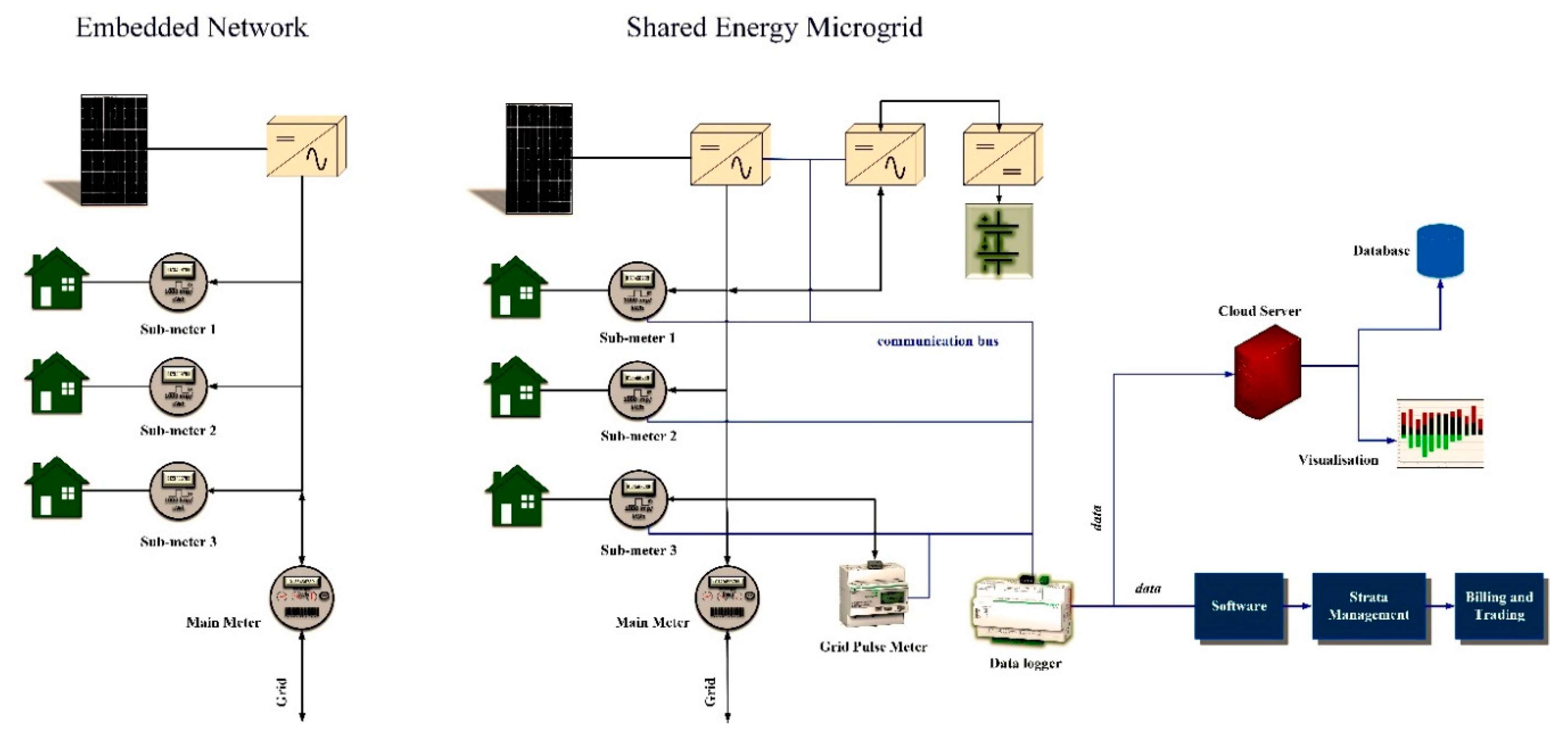

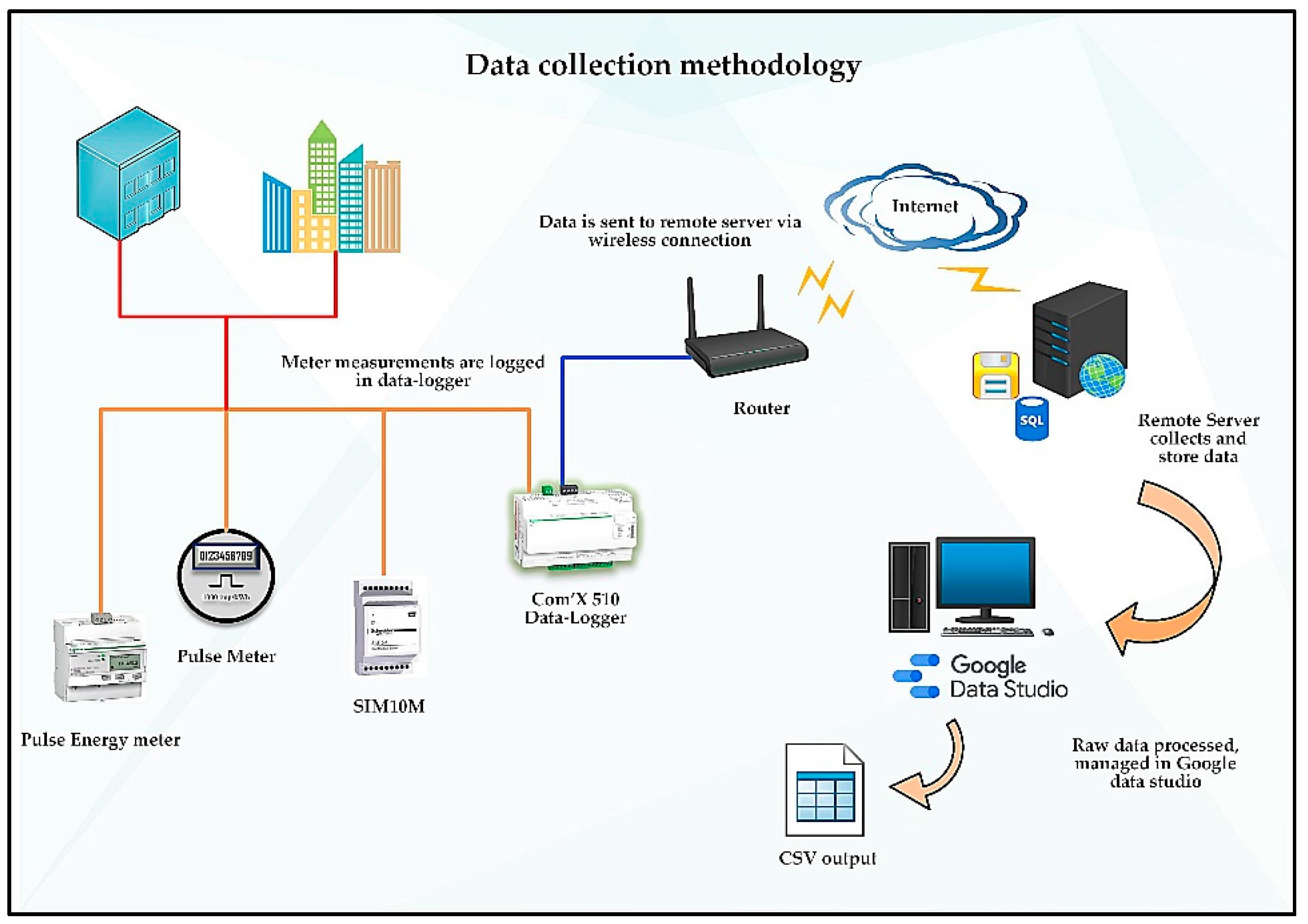
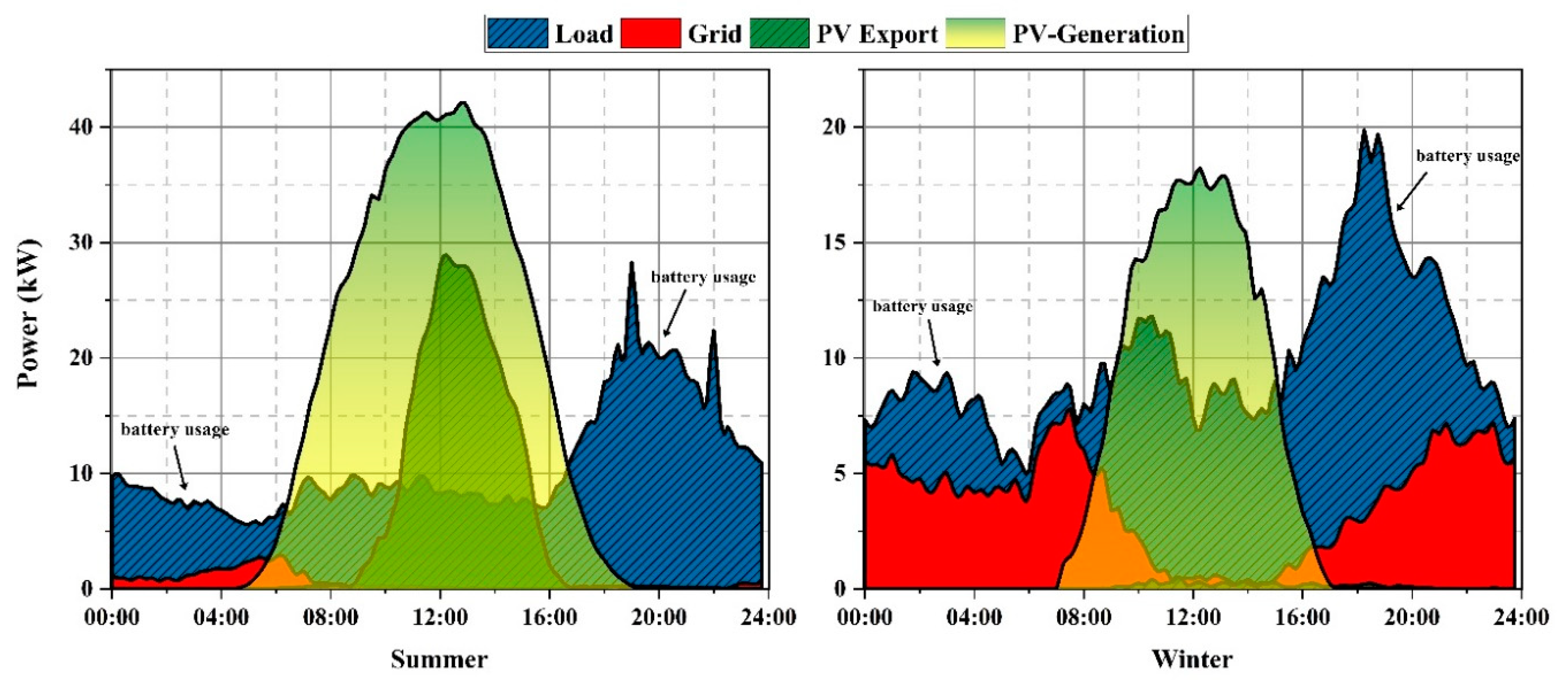
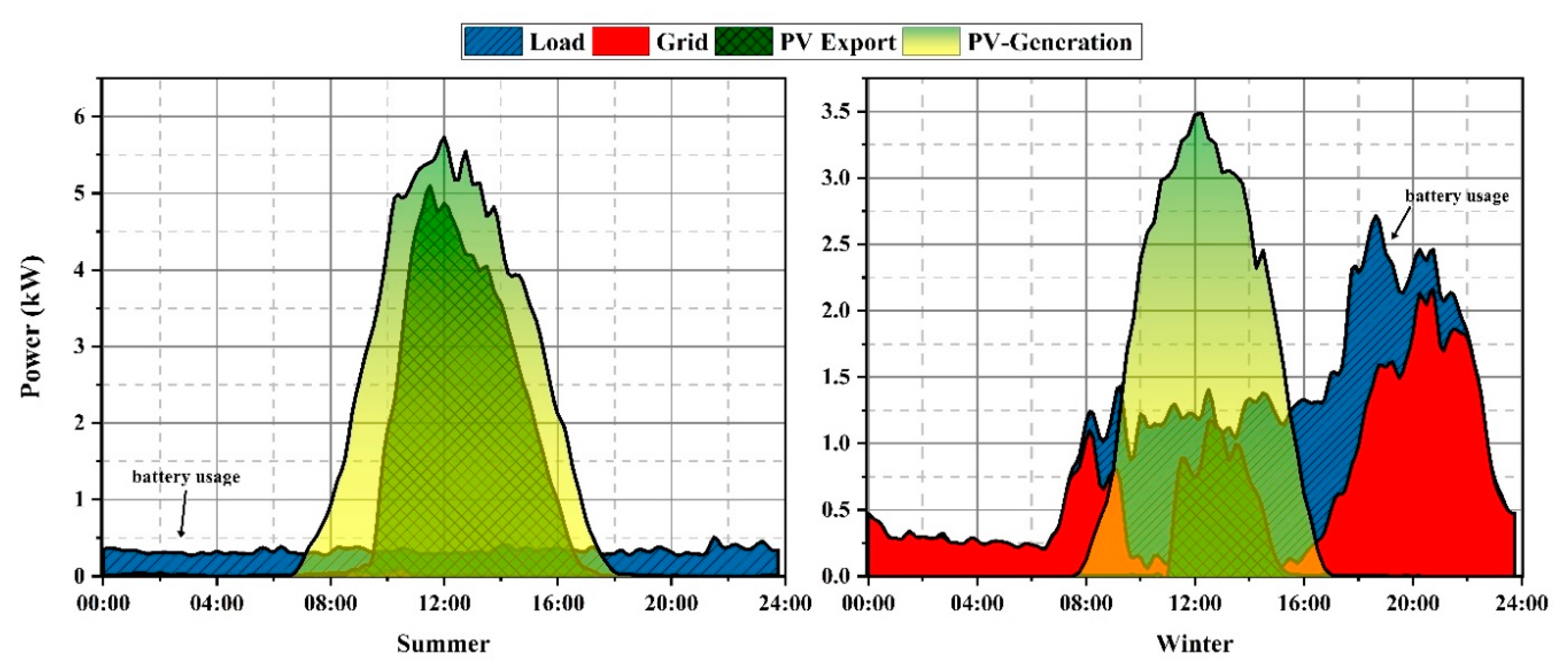
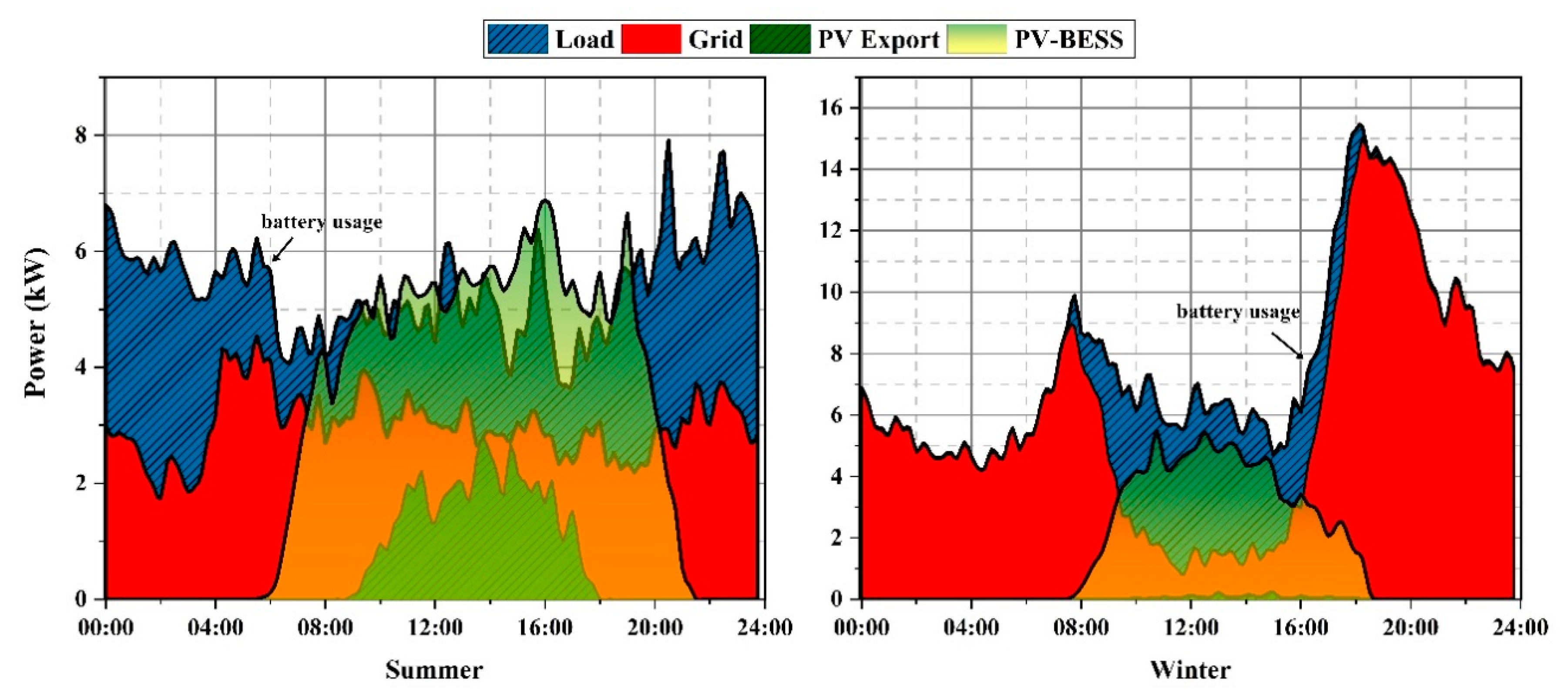

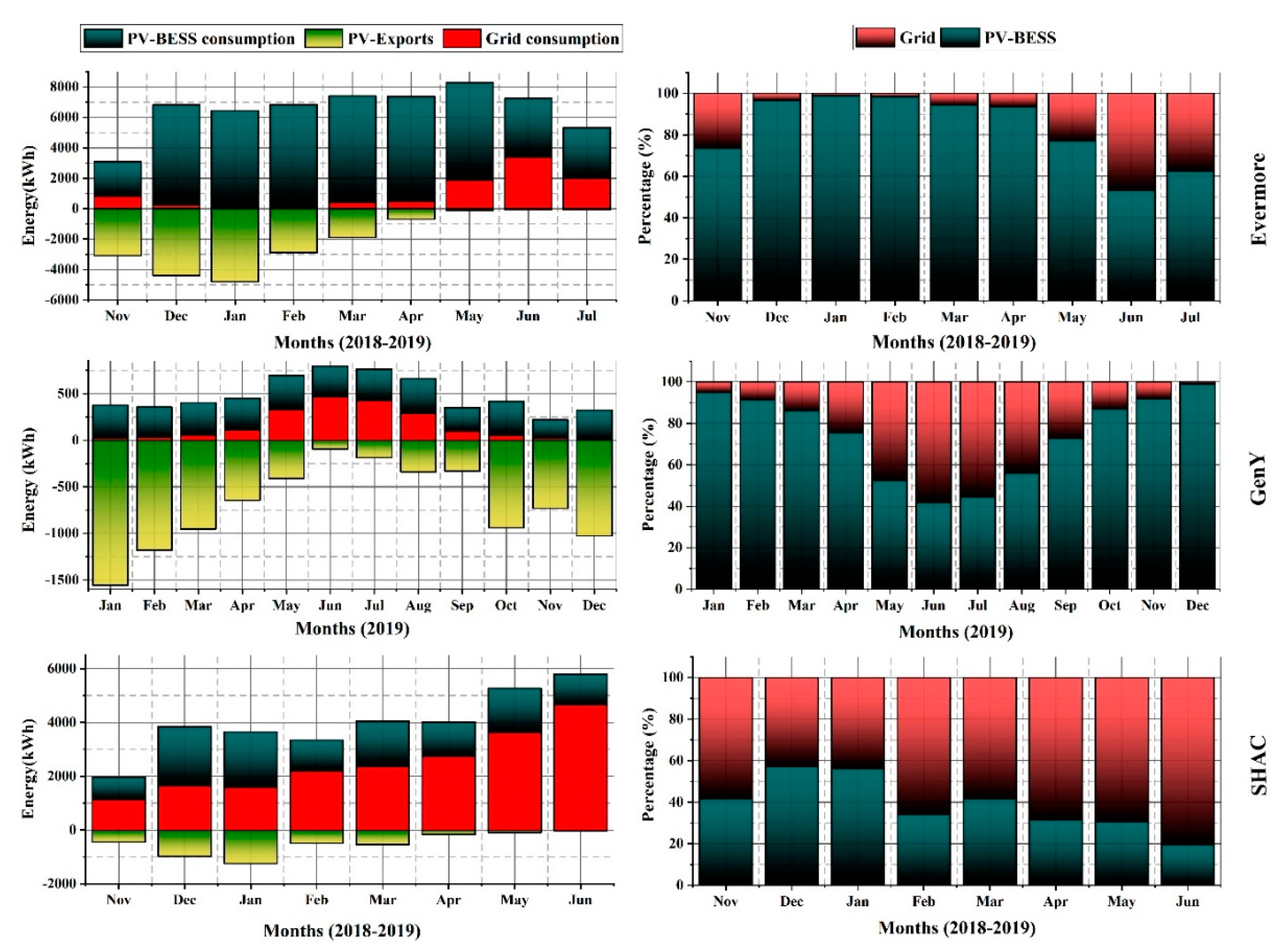
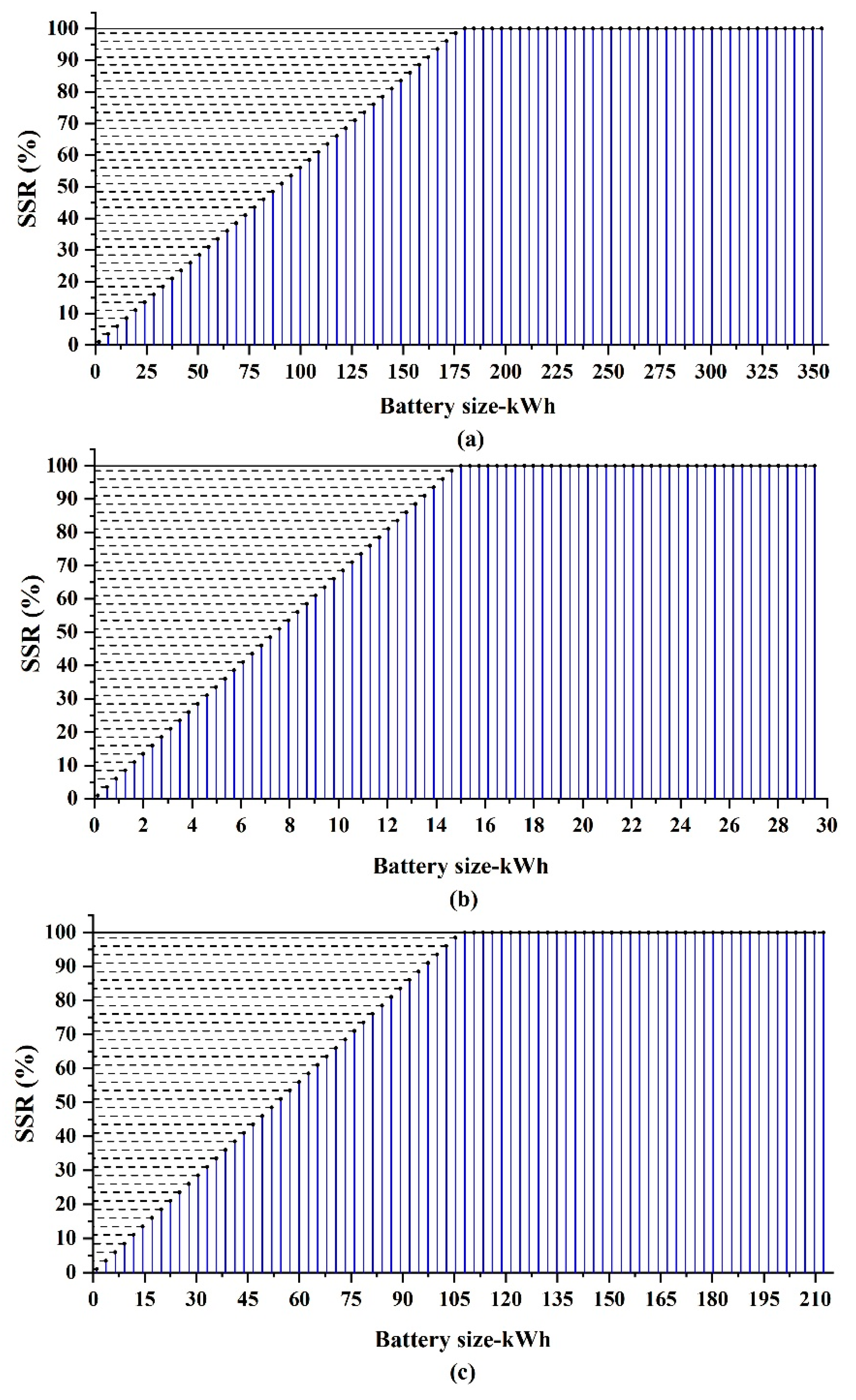
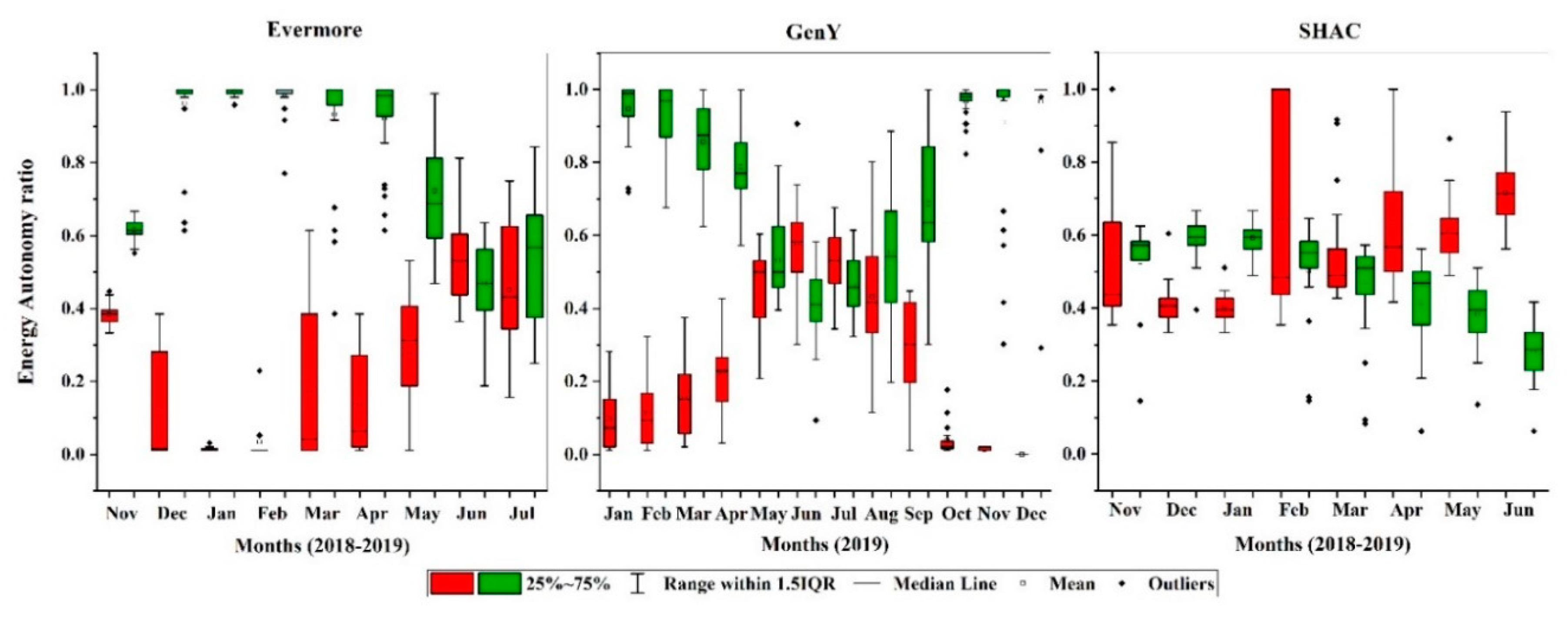
| Building | Units | System Size | Configuration |
|---|---|---|---|
| Gen Y | 3 one-bedroom | 9 kWp–10 kWh-Li-ion | AC-coupled |
| Evermore | 24 units | 54.6 kWp–150 kWh-Li-ion | AC-coupled |
| SHAC | 12, 2 shared studios | 19.6 kWp–40 kWh-Li-ion | DC-coupled |
| Building | Pulse Submeter | Energy Meter |
|---|---|---|
| Evermore | PMC-220 | IEM3255 |
| Gen Y | KMP1-50 | IEM3255 |
| SHAC | KMP1-50 | IEM3255 |
© 2020 by the authors. Licensee MDPI, Basel, Switzerland. This article is an open access article distributed under the terms and conditions of the Creative Commons Attribution (CC BY) license (http://creativecommons.org/licenses/by/4.0/).
Share and Cite
Syed, M.M.; Morrison, G.M.; Darbyshire, J. Shared Solar and Battery Storage Configuration Effectiveness for Reducing the Grid Reliance of Apartment Complexes. Energies 2020, 13, 4820. https://doi.org/10.3390/en13184820
Syed MM, Morrison GM, Darbyshire J. Shared Solar and Battery Storage Configuration Effectiveness for Reducing the Grid Reliance of Apartment Complexes. Energies. 2020; 13(18):4820. https://doi.org/10.3390/en13184820
Chicago/Turabian StyleSyed, Moiz Masood, Gregory M. Morrison, and James Darbyshire. 2020. "Shared Solar and Battery Storage Configuration Effectiveness for Reducing the Grid Reliance of Apartment Complexes" Energies 13, no. 18: 4820. https://doi.org/10.3390/en13184820
APA StyleSyed, M. M., Morrison, G. M., & Darbyshire, J. (2020). Shared Solar and Battery Storage Configuration Effectiveness for Reducing the Grid Reliance of Apartment Complexes. Energies, 13(18), 4820. https://doi.org/10.3390/en13184820





